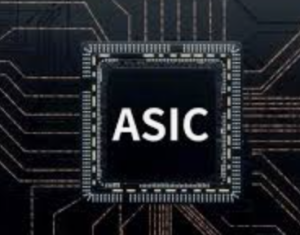
An Application-Specific Integrated Circuit (ASIC) is a custom-designed integrated circuit (IC) tailored for a specific application or task. Unlike general-purpose processors (e.g., CPUs or GPUs), ASICs are optimized to perform a particular function with maximum efficiency, offering superior performance, power consumption, and size compared to programmable alternatives. ASICs are ubiquitous in modern technology, powering everything from smartphones to Bitcoin mining rigs.
Key Characteristics:
- Customization: Designed for a single use case (e.g., audio processing, encryption).
- Optimization: High performance and energy efficiency due to dedicated circuitry.
- Fixed Functionality: Cannot be reprogrammed post-manufacturing.
2. Design and Development Process
Creating an ASIC involves a complex, multi-stage process:
- Specification: Define the chip’s purpose, performance targets, and power requirements.
- RTL Design: Capture the design in Register-Transfer Level (RTL) code using hardware description languages (HDLs) like Verilog or VHDL.
- Synthesis: Convert RTL into a gate-level netlist using Electronic Design Automation (EDA) tools.
- Verification: Simulate and test the design extensively to ensure functionality (e.g., using UVM).
- Physical Design: Floorplanning, placement, routing, and timing analysis to create the chip layout.
- Fabrication: Manufacture the chip using photolithography at a foundry (e.g., TSMC, Samsung).
- Testing: Post-production validation to detect defects.
Cost Considerations: Non-recurring engineering (NRE) costs (design, masks, tools) are high, but per-unit costs drop significantly at scale.
3. Types of ASIC Chips
ASICs are categorized by their design flexibility and customization level:
- Full-Custom ASICs:
- Designed from scratch for maximum optimization.
- Used in high-performance applications (e.g., microprocessors).
- High NRE costs and long development cycles.
- Semi-Custom ASICs:
- Standard Cell-Based: Uses pre-designed logic blocks (e.g., AND gates, flip-flops).
- Gate Array-Based: Partially pre-fabricated; customization occurs via metal layers.
- Platform ASICs:
- Built on pre-defined platforms with customizable modules (e.g., memory, I/O).
- Balances flexibility and time-to-market.
- System-on-Chip (SoC):
- Integrates ASIC cores with processors, memory, and peripherals on a single die.
- Common in smartphones (e.g., Apple’s A-series chips).
- Programmable ASICs (FPGAs):
- Field-Programmable Gate Arrays (FPGAs) are reconfigurable but less efficient than ASICs.
- Often used for prototyping before ASIC production.
4. Applications of ASICs
ASICs are critical in industries requiring specialized processing:
- Cryptocurrency Mining: Bitcoin ASICs (e.g., Bitmain’s Antminer) dominate mining due to unmatched SHA-256 efficiency.
- Consumer Electronics:
- Image signal processors (ISPs) in smartphone cameras.
- Voice assistants (e.g., Amazon Alexa’s wake-word detection).
- Automotive: LiDAR sensors, ADAS controllers, and infotainment systems.
- Telecommunications: 5G baseband processors and network switches.
- Medical Devices: Pacemakers, MRI machines, and portable diagnostics.
- Aerospace: Radiation-hardened ASICs for satellites.
5. Advantages and Disadvantages
Pros:
- Performance: Outperforms general-purpose chips in targeted tasks.
- Power Efficiency: Eliminates redundant circuitry, reducing energy use.
- Compact Size: Ideal for space-constrained devices (e.g., wearables).
- Cost-Effective at Scale: Low per-unit cost after NRE amortization.
Cons:
- High Initial Costs: NRE expenses (up to millions of dollars) limit viability for small batches.
- Design Complexity: Requires specialized expertise and EDA tools.
- Inflexibility: Cannot be updated post-production.
- Long Time-to-Market: Development cycles span months to years.
6. Future Trends and Challenges
- AI/ML Acceleration: ASICs like Google’s TPU and Tesla’s Dojo are revolutionizing machine learning workloads.
- Advanced Nodes: Transition to 3nm/2nm processes enhances performance but raises fabrication costs.
- Open-Source EDA Tools: Projects like OpenROAD aim to democratize ASIC design.
- Environmental Concerns: Bitcoin ASICs face scrutiny over energy consumption, driving interest in sustainable alternatives.
- Heterogeneous Integration: Combining ASICs with chiplets for modular, scalable designs.
7. Conclusion
ASICs represent the pinnacle of specialized computing, enabling innovations across industries through their unmatched efficiency. While challenges like high costs and complexity persist, advancements in AI, open-source tools, and semiconductor manufacturing continue to expand their applications. As technology evolves, ASICs will remain indispensable in pushing the boundaries of performance and miniaturization.
- Everything You Need To Know About Limit Switch - May 21, 2025
- Everthing You Should Know About Rheostat - May 20, 2025
- Everything You Need To Know About Reversing Contactor - May 19, 2025






